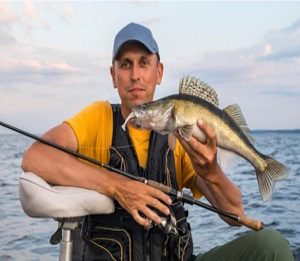 Different species of fish usually prefer specific water conditions and it’s an obvious instinct they are likely to be found where water is deep, or sometimes swift-flowing or at a certain temperature. Well, this technique is considered imperfect. By gaining knowledge about fish habits and local water conditions, fishermen end up doing increasing the odds that they will find fish at a particular location. There has been no proper assurance that fish are actually in any particular spot. So going overboard is impractical and nothing good than scaring fish away.
Different species of fish usually prefer specific water conditions and it’s an obvious instinct they are likely to be found where water is deep, or sometimes swift-flowing or at a certain temperature. Well, this technique is considered imperfect. By gaining knowledge about fish habits and local water conditions, fishermen end up doing increasing the odds that they will find fish at a particular location. There has been no proper assurance that fish are actually in any particular spot. So going overboard is impractical and nothing good than scaring fish away.
This changed during the 1950s when the development of commercial sonar devices came into existence. It had originally been developed with the purpose of detecting submarines and enabling submerged vessels to navigate.
So, commercial fishermen did not take much time to discover that sonar could also be quite helpful in finding large schools of fish that they could easily net. With time, technological advancement and miniaturization the development of small units were enabled which can be mounted on almost any craft.
How to find fish on a fish finder with ease?
For the last many years, fishermen have certainly relied on a combination of local knowledge and instinct in order to catch fish. Fish are just simple to other creatures that tend to obey a certain set of rules. Most of the fishermen would agree to the fact that fish like to live in places where they have cover from predators. The interesting part is that they are still able to seek out prey while staying hidden.
Make the use of a fish finder to explore underwater
Fishfinders operate on the same scientific principles as sonar devices. A fishfinder produces a sound and then listens to the echo, which enables the machine to know how far away an object is. If pings are used in large numbers, a fishfinder can easily determine accurately whether or not there appear to be fish, and whether there is underwater debris, obstructions, or other objects the fish are hiding in or under.
The amazing fact is that now some of the more advanced, high-resolution devices can produce clear pictures of what is beneath the surface, the shape and highly mobile nature of fish only make it possible to be represented by an icon. Still, this provides an ease to fishermen in gauging where exactly fish are, and in some cases, it even gives a good idea of how large they are.
Eliminate places where fish do not exist
The smart way to use a fish finder to find fish is by not expecting it to magically find fish within the vastness of a lake. Instead, try to eliminate places where fish aren’t, Plus, also find new places where fish like to hide. Fishfinders work more efficiently when deployed in areas where fish have been historically present or where their habits dictate they are likely to appear.
Just try to understand the fact that the goal of a fish finder is to help fishermen avoid wasting their time by eliminating out their lines in places where fish do not exist. By scanning the lake carefully, you can easily eliminate spaces that are not worth your time. The smart move would be eliminating schools of small fish, and pursuing large individual fish. You can also eliminate fish that are under local limits.
Scan a wide area
In order to use a fishfinder to find more fish, it would be better to use it to scan a wide area. Further, you can also use it to check out multiple hiding places within a lake in the pursuit of fish. With the ability of the fishfinder to examine the water underneath a boat as it passes, fishermen are best facilitated by the device when they move from one location to another. By examining the results and looking for places where multiple fish appear to be congregating, you can optimize the use of your fishfinder.
Change the lure or bait when needed
So, eliminate places where fish are not hiding and understanding how fish tend to move around a lake or river during the course of a day, you can easily determine where to best put their lines. Plus, you can also see in real-time the effectiveness of your bait or lure on a fish. If you notice that a fish doesn’t move in response to what’s being offered, a quick change of lure or bait may improve the situation.
Moreover, a fish finder will tell you whether it has been exhausted at a particular spot, or if the fish have moved to another location. Hence, by initiating with broad searches and then focusing more on the individual fish detected, you can use a fishfinder to catch more fish in less time, and with less hassle.
- What Do You Need for Fishing - August 18, 2022
- How to Find Offshore Fishing Spots - August 18, 2022
- What to Use for Trout Fishing - August 17, 2022
